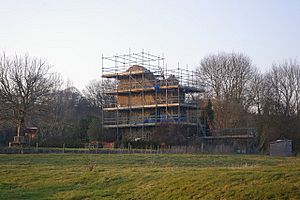Wigmore Abbey facts for kids
Wigmore Abbey was a large monastery in Herefordshire, England. It was home to a group of monks called Augustinian Canons. The abbey was built in 1179 and stayed active until 1530.
Today, only parts of the abbey are left as ruins. These ruins are in a very poor condition. They are listed on the Historic England's Heritage at Risk Register. This means they are important but need help to be preserved.
The Story of Wigmore Abbey
The idea for Wigmore Abbey started with a man named Ranulph de Mortimer. But it was his son, Hugh de Mortimer, who actually built it. The abbey was officially opened in 1179.
Other local people also helped build the abbey. They gave materials like wood and stone from their lands. Before settling in Wigmore, the monks moved around a lot. They lived in different places in Herefordshire for about 30 years.
At one point, Wigmore Abbey was thought to be the biggest monastery in the county. It was larger than Abbey Dore and Leominster Priory.
The first leader of the abbey was called Simon Merlymond. Another important leader was Andrew of St Victor, who was abbot for many years.
The abbey church was dedicated to Saint James. The powerful Mortimer family were the main supporters of the abbey. Many members of this family were buried there, including five Earls of March.
The abbey continued to thrive for many years. However, in 1530, it was closed down. This was part of a big event called the Dissolution of the Monasteries. During this time, many monasteries in England were shut by the king. After it was closed, the abbey's remains were given to Sir T. Palmer.
Wigmore Abbey is also famous for a special book. This book tells the story of the abbey and the Mortimer family. It even talks about Roger Mortimer, whose father tried to become king in 1374. This important book is now kept at the University of Chicago.
Who Was Buried at the Abbey?
Many important people from the Mortimer family were buried at Wigmore Abbey. These included:
- Ranulph de Mortimer
- Hugh de Mortimer
- Roger Mortimer of Wigmore
- Roger Mortimer, 1st Earl of March
- Roger Mortimer, 2nd Earl of March
- Edmund Mortimer, 3rd Earl of March
- Roger Mortimer, 4th Earl of March
The Abbey's Recent Story
For a long time, the land where the abbey ruins stand belonged to the Powell and Brierley families. Later, the ruins themselves were bought by a famous British actor, John Challis. He was well-known for playing Boycie in the TV show Only Fools and Horses.
John Challis lived in the only part of the abbey that survived, which was the abbot's lodging. His TV show, The Green Green Grass, was even filmed at Wigmore Abbey and other places nearby.


